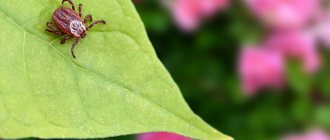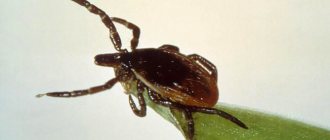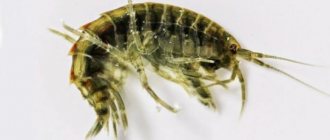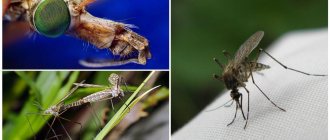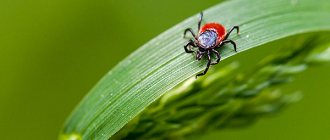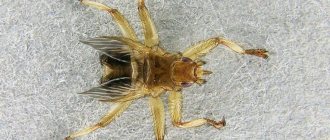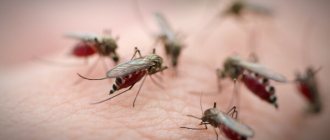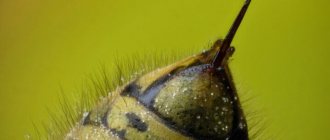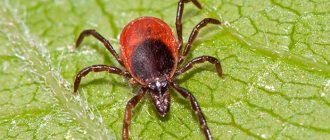The taiga tick is a common representative of ixodid ticks. This is a highly specialized parasite that feeds on the blood of its victims - all kinds of animals and humans.
Tick at gunpoint
The official literature contains information about the name of the taiga tick – Ixodes persulcatus.
Arthropods are ubiquitous and can live on shrubs, tall grass vegetation, and thickets.
They wait for a long time for their prey, which they can smell from a great distance. The bite of a taiga tick is dangerous for humans, as the parasite can carry serious diseases.
Features of the taiga tick
The taxonomy of the taiga tick is as follows:
- kingdom - animals;
- section – bilateral, bilaterally symmetrical;
- phylum – arthropods;
- class – arachnids;
- superorder – parasitiform mites;
- order – ixodid ticks;
- species - taiga tick.
The tick's food source is the blood of all warm-blooded animals, domestic or wild, and humans. Larvae and nymphs of taiga ticks attack small rodents, mice, squirrels, birds or hares.
Tick on an animal
Mature individuals pose a danger to humans; nymphs rarely bite people. The eyes of the arachnid are not developed; they capture potential prey using thermoreceptors.
The smell of an animal or person is felt at a distance of about twenty meters, moving in the right direction. From a distance of half a meter, the arthropod distinguishes the body heat of the prey.
Parasites concentrate near roads and forest paths. Sitting on tall grass or tree branches, ticks cling to the body of the victim with the help of two front legs. By pulling them forward, when the opportunity arises, they catch on the clothing or fur of the animal.
Taiga tick bite
Then they look for the most suitable place on the victim’s body and stick to the skin. While hunting, ticks sit in vegetation at a height of no more than a meter from the ground.
They attack small animals by falling from above. When approaching a person or large animal, the parasites attach themselves to the legs, moving up the body in search of thin skin. Most often they bite through the skin in the groin, neck, abdomen or armpits.
Appearance
The taiga tick is small in size, which is why it is so difficult to detect in the grass or on the body. An adult hungry female has a flat, rounded body. Its length is about 4 mm, rarely reaching 6 mm.
Dimensions of the taiga tick
Having drunk blood, the parasite increases significantly in size.
The structure of the taiga tick makes it look like a small spider - a body with 8 dark legs located on the sides.
Tick structure
On the wedge-shaped head there is a proboscis with sharp jaws. It is with their help that the parasite makes a hole in the victim’s skin.
Males and females are distinguished by certain differences - structure and color. The male tick has a chitinous cover, colored black.
Male and female tick
The female individual has a similar shell, but in her it occupies only a third of the entire body. The rest of the body consists of folds of skin that stretch when the abdomen fills with blood.
The female's body increases 5-8 times. Color black-red or brown-red.
Adult female tick
Their size is much larger than that of males, whose maximum length is 2.8 mm.
Habitat and food
Initially, the tick's habitat was in the taiga part of Siberia. Over the past hundred years, the arachnid's habitat has expanded significantly for a number of reasons, including significant climate warming.
Towards the west, the parasite's distribution border includes the Baltic states, Belarus, and the southeastern part of Finland. In the north, the territory ends near Petrozavodsk, in the south – in the Ulyanovsk and Samara regions.
The eastern border ends at the Pacific Ocean. The taiga parasite is found in Japan, in the east and north of China, on Sakhalin, the Kuril Islands and Kamchatka. There are isolated islands of tick-infested areas in the mountain ranges of Central Asia.
Life and reproduction
The life cycle of the taiga tick includes two main aspects - reproduction and the search for a source of blood.
During the hunting season, arachnids are located in the grass, on bushes or on the lower branches of trees, waiting for potential prey. The parasite does not rise above a meter.
Path in the forest
At this time, ticks move towards paths and roads, and less often remain in dense bushes or meadows. Prefer moist, dark places.
Ticks live in wild places, and they can be found in city parks, cemeteries, and summer cottages. They can get here with the help of birds, rodents, animals or humans. It is a mistake to think that you can only be afraid of a bite in the forest.
Mating begins in the spring. The process can occur in the environment or at the moment when the female, having sucked, drinks blood. A fed and fertilized female lays from 1.5 to 2.5 thousand eggs.
Ixodid tick egg laying
After two to three weeks, larvae emerge from the eggs, 0.5 mm long and with six legs.
While developing, the larvae drink the blood of rodents or birds for several days. Upon returning to the forest, they molt, moving to a new stage of maturation - they become nymphs. Nymphs already have eight legs and reach a length of up to 1.5 mm.
Life cycle of a tick
At this stage of development, the tick overwinters, after which it begins to hunt larger representatives of warm-blooded animals and humans, including. After another moult, the nymphs turn into adult ticks by the following spring.
You can also read our article: How long does a tick live, which affects the life expectancy of the parasite
Why is the taiga tick dangerous?
The bite of a blood-sucking parasite is not dangerous - the affected area turns red, swells, and a point of dried blood appears in the center.
Such traces are left behind by a larva, nymph or male. Once they get drunk, they disappear on their own.
The female, having sucked, goes deeper into the body of the victim. It penetrates deep until the entire head is under the skin.
Tick embedded in skin
You need to pull the parasite out of the wound with skillful movements, otherwise its head will remain in the body.
The part of the tick that is torn off and remains under the skin can cause an inflammatory process and suppuration will begin. This is just one example of how dangerous the taiga tick is.
The process of removing a tick by a doctor
To remove it correctly, it is better to contact a medical facility.
How to detect a tick on the body
The parasite can be detected by carefully examining the body after visiting a forest or cottage.
Inspecting the body for ticks
It is advisable to remove outer clothing in front of the door and shake it out thoroughly.
After a walk in the city park, your pet can bring it home. It is imperative to inspect the fur and body of the animal to identify arthropods.
Symptoms of diseases
It is a known fact that taiga ticks are carriers of encephalitis.
Today, five types of the disease are known:
- febrile form of encephalitis - high temperature, lethargy, headache, nausea, sleep disturbance;
- meningeal form of encephalitis - serious complications in the form of hydrocephalus and epileptic seizures;
- polyradiculoneuritic form of encephalitis - the brain and nervous system are affected, sensitivity of the limbs disappears;
- meningoencephalitic form - vomiting, hallucinations, impaired consciousness, often ends in irreversible changes in the brain.
How to protect yourself
It is important to choose the right clothes when going for a walk in the forest. It should be light, made of dense fabric.
Line of anti-tick suits BIOSTOP
The sleeves are long, with cuffs, and the bottom of the trouser legs is tucked into the shoes. It is better to avoid overgrown paths in the forest.
Residents of regions where there is a high risk of contracting encephalitis are recommended to get vaccinated.
Using chemicals and listening to the advice of experts, you can protect yourself from tick bites.
If you find an attached parasite on your body, it is better to seek medical help.
homeWelcome to the unofficial website of the staff of the Department of Medical Biology and Genetics of KSMU!
General information about the organization of the educational process at the Department of Medical Biology and Genetics of KSMU
Educational and educational work at the department is carried out in accordance with the following documents:
- State educational standard
- Qualification characteristics of a specialist
- Curriculum for training specialists
- Biology curriculum
- Biology work program
- Study timetable
- Plan of educational and methodological work
The educational process is organized using elements of the following educational systems:
- Information system
, focused on mastering knowledge, skills and abilities in their subject content, in which mastering the content of educational programs is understood as memorizing (memorizing) a certain amount of information, the overall result of the study is considered to be the acquisition of knowledge - “a store of knowledge”, and the main criterion for assessing the activities of the student and teacher is the amount of knowledge acquired by the student;
- operating system
, in which the student develops a clear understanding of what and how to do, and an activity-based approach to acquiring new knowledge is implemented: the student, using visual guidelines, acquires new knowledge and skills in the process of carrying out educational activities;
- person-oriented system
, in which the main emphasis is on cooperation between student and teacher in the educational process, on creating conditions for the self-development of the student’s personality, realizing his creative potential and encouraging him to meaningfully master the basics of his future professional activity.
Training is conducted on the basis of a modular organization
educational process using
a rating system
for assessing students' knowledge.
Main organizational forms
studies at the department are:
- lectures
,
- practical lessons
,
- test papers
,
- independent work.
Throughout the academic year
students of the following faculties study biology:
- therapeutic and prophylactic
- pediatric
- medical and preventive
- dental.
At the end of the first semester, students of these faculties undergo certification
, and at the end of the second semester they take
a test on preparations
of parasitic animals and a final
exam
in biology.
For one semester
students of the following faculties study biology:
- pharmaceutical
- Faculty of Management and Higher Nursing Education (MFSE).
At the end of the semester, students of these faculties take a final exam
in biology.
For most students, traditional group learning is organized; For some students, training can be organized according to an individual plan
studying biology.
Additional organizational forms of training are
- student scientific circle
- biological KEVN
- Olympics.
Much work is being done to develop and use distance learning
.
The site provides didactic material for distance learning.
The active creative participation of students in the development of didactic material and computer programs, the introduction of elements of innovative pedagogical technologies
.
We invite everyone to participate in competitions and olympiads in biology.
Textbooks, methodological recommendations, thematic plans for lectures, practical classes and midterm tests allow each student to have a clear understanding of
- goals and objectives of each stage of training,
- content of education,
- forms and methods of knowledge control.
The organization of the educational process at the department allows each student to actively participate in the educational process, taking into account their goals, requests, interests and intellectual and psycho-physiological characteristics of their personality, ultimately achieving the desired results.
Date of last update 17.09.2010.
Site administrator - Associate Professor V.N. Frosin (tel. 240-41-24)
